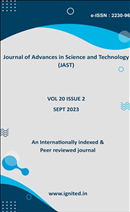Data Mining and Mathematical Models in Cancer Prognosis and Prediction
DOI:
https://doi.org/10.29070/1krjj876Keywords:
Cancer prognosis, prediction models, machine learning, clinical decision supportAbstract
There has been tremendous progress in cancer prognosis and prediction thanks to data mining and mathematical modelling techniques. Due to the exponential expansion of genomic, proteomic, and clinical information, conventional diagnostic tools are no longer enough for rapid and reliable evaluations. With the use of mathematical models, we may theoretically estimate tumour development, metastasis, and treatment responses, and data mining can help us find important patterns and information in large datasets relevant to cancer. To improve cancer prognosis and prediction systems, this study investigates how mathematical modelling approaches like differential equations and Markov models, as well as data mining algorithms like neural networks and support vector machines, can work together. In order to help achieve more tailored and accurate cancer treatment, the article goes on to talk about present trends, obstacles, and the potential future of using computational intelligence in oncology.
Downloads
References
Magalhaes, PP. CagA status of helicobacter pylori infection and p53 gene mutations in gastric adenocarcinoma. Carcinogenesis 2003;24:145.
Wang, J, Zhang, K, Wang, E. Kinetic paths, time scale, and underlying landscapes: a path integral framework to study global natures of nonequilibrium systems and networks. J Chem Phys 2010;133:125103.
Lehuédé, C, Dupuy, F, Rabinovitch, R, Jones, RG, Siegel, PM. Metabolic plasticity as a determinant of tumor growth and metastasis. Cancer Res 2016;76:5201–8.
Obre, E, Rossignol, R. Emerging concepts in bioenergetics and cancer research: metabolic flexibility, coupling, symbiosis, switch, oxidative tumors, metabolic remodeling, signaling and bioenergetic therapy. Int J Biochem Cell Biol 2015;59:167–81.
Graziano, F, Ruzzo, A, Giacomini, E, Ricciardi, T, Aprile, G, Loupakis, F, et al.. Glycolysis gene expression analysis and selective metabolic advantage in the clinical progression of colorectal cancer. Pharmacogenomics J 2016;17:258–64.
Elia, I, Schmieder, R, Christen, S, Fendt, SM. Organ-Specific Cancer Metabolism and Its Potential for Therapy. Handb Exp Pharmacol. 2016;233:321–53.
Li, W, Wang, J. Correction to ‘uncovering the underlying mechanism of cancer tumorigenesis and development under an immune microenvironment from global quantification of the landscape’. J R Soc Interface 2021;18:20210247.
Dunn, GP, Bruce, AT, Ikeda, H, Lloyd, JO, Schreiber, RD. Cancer immunoediting: from immunosurveillance to tumor escape. Nat Immunol 2002;3:991–8.
Chong, Y, Liu, Q, Chen, C, Wang, J. Quantification of the underlying mechanisms and relationships among cancer, metastasis, and differentiation and development. Front Genet 2020;
Xu, L, Zhang, K, Wang, J. Exploring the mechanisms of differentiation, dedifferentiation, reprogramming and transdifferentiation. PLoS One 2014;9:e105216.
Li, C, Wang, J. Quantifying cell fate decisions for differentiation and reprogramming of a human stem cell network: landscape and biological paths. PLoS Comput Biol 2013;9:e1003165.






